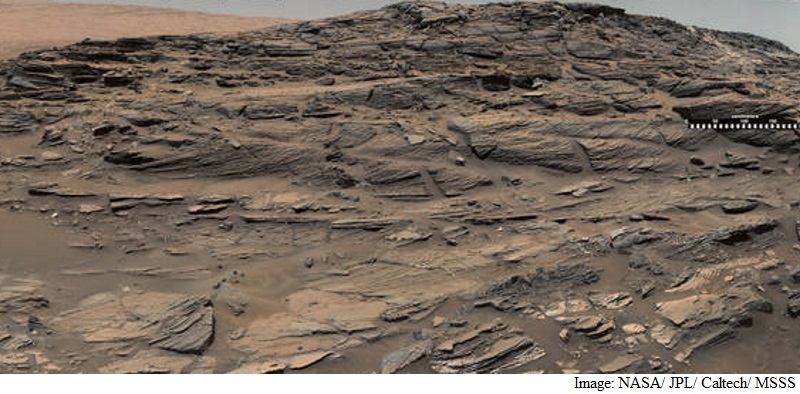- Home
- Science
- Science News
- Nasa's Curiosity Rover Captures Petrified Sand Dunes on Mars
Nasa's Curiosity Rover Captures Petrified Sand Dunes on Mars

This sandstone outcrop - part of a geological layer that Curiosity's science team calls the Stimson unit - has a structure called crossbedding on a large scale that the team has interpreted as deposits of sand dunes formed by wind.
Similar-looking petrified sand dunes are common in the US southwest.
"Geometry and orientation of the crossbedding give information about the directions of the winds that produced the dunes," the US space agency said in a statement.
The Stimson unit overlies a layer of mudstone that was deposited in a lake environment.
Curiosity has been examining successively higher and younger layers of Mount Sharp, starting with the mudstone at the mountain's base, for evidence about changes in the area's ancient environment.
Outcrops of the Stimson unit sandstone are still accessible to the rover and researchers plan to use the rover to collect and analyse a drilled sample of Stimson unit sandstone this month.
Curiosity has been working on Mars since early August 2012. It reached the base of Mount Sharp last year after fruitfully investigating outcrops closer to its landing site and then trekking to the mountain.
For the latest tech news and reviews, follow Gadgets 360 on X, Facebook, WhatsApp, Threads and Google News. For the latest videos on gadgets and tech, subscribe to our YouTube channel. If you want to know everything about top influencers, follow our in-house Who'sThat360 on Instagram and YouTube.
Related Stories
- Samsung Galaxy Unpacked 2025
- ChatGPT
- Redmi Note 14 Pro+
- iPhone 16
- Apple Vision Pro
- Oneplus 12
- OnePlus Nord CE 3 Lite 5G
- iPhone 13
- Xiaomi 14 Pro
- Oppo Find N3
- Tecno Spark Go (2023)
- Realme V30
- Best Phones Under 25000
- Samsung Galaxy S24 Series
- Cryptocurrency
- iQoo 12
- Samsung Galaxy S24 Ultra
- Giottus
- Samsung Galaxy Z Flip 5
- Apple 'Scary Fast'
- Housefull 5
- GoPro Hero 12 Black Review
- Invincible Season 2
- JioGlass
- HD Ready TV
- Laptop Under 50000
- Smartwatch Under 10000
- Latest Mobile Phones
- Compare Phones
- Moto G15 Power
- Moto G15
- Realme 14x 5G
- Poco M7 Pro 5G
- Poco C75 5G
- Vivo Y300 (China)
- HMD Arc
- Lava Blaze Duo 5G
- Asus Zenbook S 14
- MacBook Pro 16-inch (M4 Max, 2024)
- Honor Pad V9
- Tecno Megapad 11
- Redmi Watch 5
- Huawei Watch Ultimate Design
- Sony 65 Inches Ultra HD (4K) LED Smart TV (KD-65X74L)
- TCL 55 Inches Ultra HD (4K) LED Smart TV (55C61B)
- Sony PlayStation 5 Pro
- Sony PlayStation 5 Slim Digital Edition
- Blue Star 1.5 Ton 3 Star Inverter Split AC (IC318DNUHC)
- Blue Star 1.5 Ton 3 Star Inverter Split AC (IA318VKU)

















